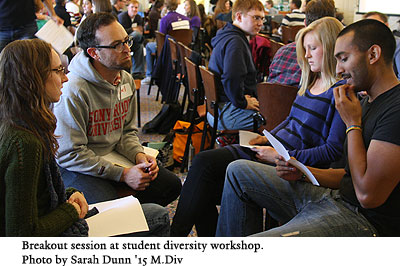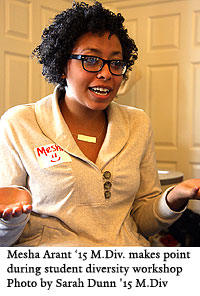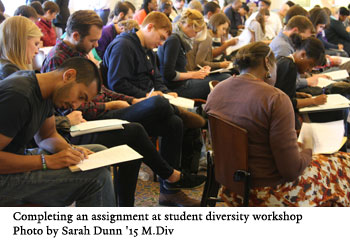On the evening of Nov. 15, YDS students gathered to watch “Race: The Power of an Illusion,” a 2003 PBS documentary that investigates the ways in which American law, citizenship, and economics created and reinforced white privilege. The film screening was but the latest event in a year-long initiative on racial justice and inclusivity that will include a community-wide reading of the book The New Jim Crow: Mass Incarceration in the Age of Colorblindness and a visit by the author.
 The new diversity initiative traces its roots to the YDS Diversity Committee’s decision in spring 2012 to support the Student Council in hosting a series of Town Hall meetings on inclusion, including issues related to welcoming differences into the culture of a community. “As these meetings unfolded, it became clear that students really did want to talk about race, in particular, but also lacked some basic tools for how to hold the conversation,” recalled Mary Clark Moschella, the Roger J. Squire Professor of Pastoral Care and Counseling.
The new diversity initiative traces its roots to the YDS Diversity Committee’s decision in spring 2012 to support the Student Council in hosting a series of Town Hall meetings on inclusion, including issues related to welcoming differences into the culture of a community. “As these meetings unfolded, it became clear that students really did want to talk about race, in particular, but also lacked some basic tools for how to hold the conversation,” recalled Mary Clark Moschella, the Roger J. Squire Professor of Pastoral Care and Counseling.
According to Moschella, at about the same time student Marilyn Kendrix ‘13 M.Div. was reading Michelle Alexander’s The New Jim Crow and suggested to several professors that the book be the focus of an all-school book read. The New Jim Crow argues that the U.S. criminal justice system functions as a contemporary form of racial control, despite its formal pretense of colorblindness, or non-racialism.
An ad-hoc steering group was formed, consisting of Moschella, Kendrix, Assistant Dean Julie Kelsey, and Thomas Troeger, the J. Edward and Ruth Cox Lantz Professor of Christian Communication, leading to approval of a budget allowing for a series of events that would address both the need for racial inclusion inside the YDS community but also the call to do racial justice work in the larger world.
 Allies for Change, a Michigan-based antiracist and anti-oppression training organization was brought in, and two separate trainings were held in October—one for the faculty and one for students—modeling clear communication and honest reflection.
Allies for Change, a Michigan-based antiracist and anti-oppression training organization was brought in, and two separate trainings were held in October—one for the faculty and one for students—modeling clear communication and honest reflection.
Faculty were provided with resources, such as a list of best practices for racial inclusion in the classroom, and a set of guidelines for how to have conversations related to race. The student training was an all-day event that offered guidelines, definitions of racism and white privilege, a film on the history of race in the US, and plenty of time for small groups to enter into discussion.
Free copies of The New Jim Crow have been distributed to all students and faculty, with expectations that everyone will read it and take part in a Feb. 25 All-School Conference talk by author Michelle Alexander. Two more conversations about the book will be hosted by YDS.
Kendrix said, “Using the tools we’ve acquired during the first phase to help us address the issues of systemic racism and the resultant mass incarceration presented in this book, we will have an opportunity next semester to hear from the author when she comes to speak and then engage one another in conversations about the issues presented in the book.”
The November screening of “Race: The Power of an Illusion” sought to capitalize upon the enthusiasm from the diversity initiative’s Oct. 12, daylong training on anti-racism. Following the screening, organizers facilitated a discussion at which some students commented that the training was a significant step forward in YDS’s initiatives on inclusion, racial justice, and diversity. Others believed that while the training offered important historical, social, and political information, it did not equip them with a toolkit to address contemporary issues of racial justice.
 At the Oct. 12 event, the Allies for Change facilitators showed excerpts of the documentary to illustrate the historical, legal, social, and economic expressions of white privilege—a social context that advances systemic unearned advantages for people of white skin color. Much of the documentary focused on events in the twentieth century to demonstrate that white privilege and structural racism continued long after the official end of slavery in the U.S.
At the Oct. 12 event, the Allies for Change facilitators showed excerpts of the documentary to illustrate the historical, legal, social, and economic expressions of white privilege—a social context that advances systemic unearned advantages for people of white skin color. Much of the documentary focused on events in the twentieth century to demonstrate that white privilege and structural racism continued long after the official end of slavery in the U.S.
“I have received a good deal of feedback on the programs that were held, mostly positive, with a few complaints as well,” said Moschella. “Most gratifying is the fact that the Student Council has stepped up to help lead ongoing conversations in the community. The Diversity Committee hopes to find ways to keep the ball rolling in the coming years, with foci on different types of diversity and inclusion (LGBTQ, religious, class) each year, yet without losing our concern for racial inclusion and racial justice in the larger world. Dean Sterling has given his full support.”
In the more immediate future, South African anti-apartheid activist Allan Boesak will visit campus on February 5-7, and the spring issue of Reflections magazine will address the topic of race.
“This project is one that can contribute to the many ways that YDS seeks to live into the school’s mission to train leaders for church and society across ecumenical and international difference with a commitment to social justice,” said Kendrix.
* Gustav Spohn, director of communications and publications, also contributed to this article.
| Attachment | Size |
|---|---|
| 5.77 KB |